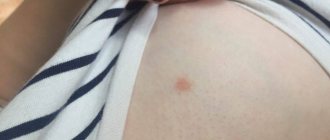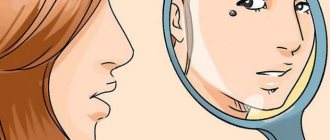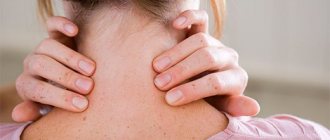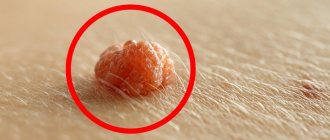It is difficult to find a person who does not have moles on his body. Doctors call these noticeable growths nevi and classify them as tumors. Most moles are benign. Why does a mole hurt and what to do if a symptom occurs? The appearance of pain is often a consequence of injury or mechanical damage, or may arise due to the development of pathological processes. In some people, the symptom is associated with the formation of a cancerous tumor - melanoma. In all cases, it is recommended to visit a medical facility for consultation and examination.
What factors can provoke pain in a mole?
When examining a newborn baby, you can notice moles on his body - such nevi are congenital. They are often hereditary. Over the course of a person's life, new moles may appear. The prerequisites for their occurrence can be associated with various events :
- injury to the skin and soft tissues;
- exposure to direct sunlight;
- increasing radiation levels;
- changes in hormone balance;
- damage to the body by infection or viruses.
© shutterstock
Experts name two groups of reasons when pain appears in a mole - exposure to external stimuli and internal causes. Pain in a mole is also observed if there is an impact on the formation itself, nearby nervous tissue, blood vessels, sweat or sebaceous glands, and hair follicles.
Usually a mole begins to hurt if its owner suffers injury. Rubbing with clothing, careless hygiene procedures, blows, cuts, any burns, or pricks with a sharp object cause damage to the integrity of the nevus. Its membranes are destroyed, the endings of the nerve tissues lose their protection, so pain appears. The symptom may be associated with changes in body or environmental temperature. Its fluctuation accompanies many diseases. Nevi hurt when the functions of internal organs or endocrine and gonads are impaired. You should familiarize yourself with the common reasons when a mole hurts in more detail.
Why does a mole turn red, enlarge and become painful?
The fact is that inflammation can begin in the area of hair follicles and sebaceous glands. As a rule, the sebaceous gland becomes inflamed, the excretory duct of which opens into the hair follicle.
In medicine, inflammation of the sebaceous gland and hair follicle is called a furuncle, popularly called a “ pimple.”
«.
This happens for a variety of reasons, from pollution and microtrauma of the skin to metabolic disorders. As you can see in the picture below, all inflammation phenomena appear in the area of the mole:
Mechanical injury
A mole hurts when touched if its tissue has been mechanically damaged. The nevus is injured in different ways - it can be rubbed when wearing clothes or shoes, its tissues are damaged by cuts, bruises, and punctures with sharp objects. A mole on the head may begin to hurt after washing and combing your hair, changing your sleeping position, or wearing a hat.
© shutterstock
A hanging mole or one that protrudes above the surface of the skin often hurts. Any injury involves a violation of the integrity of the tissue - pain in the mole occurs for this reason. There is a great danger of developing inflammation, because microbes, viruses, fungi can enter a damaged nevus from the environment and begin active reproduction. To prevent infection from occurring, you need to see a doctor. Depending on the situation when a mole injury occurred and pain occurred, experts advise the following actions :
- if a mole is completely torn off, it cannot be thrown away, it must be saved for research;
- the wound should be treated with an antiseptic agent and carefully covered with a sterile bandage;
- For most patients, if the integrity of the nevus is damaged or pain occurs, it is necessary to completely remove its tissue and conduct the necessary tests.
In addition to surgical removal of the mole after its injury, additional treatment is necessary. The patient is prescribed painkillers and anti-inflammatory drugs.
Melanoma formation
Sometimes a person may notice that his mole is growing and hurting, and other metamorphoses are occurring with it. Such changes may indicate a dangerous degeneration of an ordinary nevus into melanoma - skin cancer. A cancerous tumor can grow deep into the tissue or into the superficial layers of the skin. The process is characterized by rapid spread and active formation of metastases.
© shutterstock
An ordinary, “harmless” mole can become melanoma and become very painful in several cases. Provoke the degeneration of nevus cells (melanocytes) into cancer hazards :
- damage to a mole of a mechanical nature, injury when its structure is disrupted;
- active exposure to ultraviolet radiation;
- genetic predisposition, presence of melanoma in close relatives;
- changes in the body of a hormonal nature, the most dangerous are adolescence, pregnancy, menopause, the presence of pathologies of the endocrine system;
- decreased immune defense;
- the presence of a large number of moles on the body;
- bright skin.
The transformation of moles into melanoma is observed in people belonging to the middle and older age groups. According to statistics, this type of cancer often develops in men.
The main sign indicating the presence of melanoma is pain - the mole hurts when pressed and without such pressure. The spot becomes asymmetrical, has an uneven color, with darkening and light areas . Its edges become ragged or fuzzy. The mole rises noticeably above the surface of the skin. Its structure becomes loose, bleeding and pus appear, and crusts form. There is a burning sensation and pain around the mole, which intensifies over time. In advanced stages, when cancer is accompanied by metastasis, a person rapidly loses weight, his lymph nodes enlarge, his skin becomes gray, his head hurts severely, and a persistent cough appears.
The presence of pain in a mole against the background of its structural changes cannot be ignored. You should contact a medical facility immediately. To diagnose melanoma, a visual examination of the nevus is used, and tests of the patient’s blood and urine are performed. A tissue biopsy (excisional and incisional), a cytological examination of lymph node puncture, and instrumental studies to identify changes in internal organs are required. The doctor assesses the depth of tissue damage by the tumor using infrared radiation.
If a mole has enlarged and hurts and causes discomfort, you must not allow it to degenerate into melanoma. The nevus needs to be removed. The procedure uses gentle methods - surgery using a laser or radio waves, removing the mole with a scalpel and capturing damaged tissue. If the diagnosis of melanoma is confirmed, courses of chemotherapy and immunotherapy are necessary. The prognosis for the patient directly depends on the stage at which melanoma was detected and the formation was removed.
Exposure to ultraviolet radiation
A symptom where birthmarks hurt may indicate the negative effects of ultraviolet radiation. For pain to occur, a person does not have to deliberately lie for a long time and regularly on the beach or sunbathe - just walking down the street, working or relaxing in the open air is enough.
© shutterstock
Ultraviolet radiation usually affects moles that are located on open areas of the body - arms, face, legs, neck . The appearance of pain in the nevus itself, redness of exposed skin, severe itching and burning, increased body temperature, weakness and signs of fever directly indicate that the person has been actively exposed to ultraviolet radiation. The mole may become inflamed. If the pain persists, you should contact the clinic. After an examination, the doctor may decide to remove the nevus. After surgery, he will prescribe anti-inflammatory treatment and medications to relieve pain.
During the period of active sun, you need to wear clothes and hats that hide areas of the body with moles. It is necessary to use sunscreens or sprays and limit exposure to the street during dangerous hours.
Allergic processes
Such skin reactions are increasingly common among modern people.
Allergic pimples usually do not hurt, they are numerous and itchy.
May be accompanied by a burning sensation.
Extensive rashes may affect pigmented areas of the skin.
As a result, everything looks as if a person suddenly developed a lot of pimples in the form of moles.
If the allergy is quite active, then after the process subsides and resolves, peeling and crusts remain.
You cannot rip it off, as it can easily cause infection.
Increasing the size of a mole
Pain in a mole can occur when it is actively growing. When it increases in size, its cells quickly divide, grow, and affect the nerve endings in the skin and soft tissues, squeezing them. Any rapid growth of a nevus should alert you - an increase in the size of a mole in a short period of time may indicate its degeneration into a malignant tumor. Therefore, visiting a doctor immediately is very important.
© shutterstock
Pain in a mole as its size increases is typical for several situations.:
- development of the process according to a malignant “scenario”;
- the presence of diseases of the endocrine system;
- the appearance of hormonal imbalance during pregnancy, age-related female changes;
- after treatment with hormonal drugs;
- in case of injury or exposure to dangerous ultraviolet radiation.
The doctor conducts an external examination of the patient and decides on the choice of instrumental diagnostic method - cytological analysis, tomography. A blood test is ordered to check for the presence of tumor markers. The problematic mole is removed.
Dermatoscopy of a pimple on a mole
Dermatoscopy allows one to establish the nature of the process with sufficiently high accuracy.
This is a non-invasive technique.
Its essence is to study a suspicious area of skin at high magnification and under bright light.
This way you can look at the signs of inflammation in the area of the mole - an expanded capillary network, swelling of cells and intercellular space, accumulation of immune tissue macrophages.
The formation of new vessels, atypical cell shape, growth of melanocytes beyond the pigment layer, and infiltration of the basal epithelium speak in favor of the neoplasm.
Change in air temperature
There are a huge number of nerve endings on the human skin. Changes in ambient temperature negatively affect moles and can cause pain in them. The temperature regime that is comfortable for humans corresponds to approximately 20 degrees Celsius. Unfortunately, such indicators are observed for a short time. In the summer there is a noticeable increase in the indicator, and in the autumn-winter there is a significant decrease. The skin takes an active part in the process of thermoregulation. When the temperature changes dramatically, the skin tissues and moles located within them experience stress and pain.
© shutterstock
When the situation persists and there is pain in the moles, which can intensify when pressed, you need to consult a doctor. He will conduct a visual examination of the patient, and if there is a change in the structure of the nevus, he will prescribe an additional study - a biopsy of its tissue. Often a decision is made to remove a growth or several.
Other causes of pain in a mole
According to statistics, the most common cause of pain in a mole is its trauma. One of them is a chemical burn. In everyday life - at home, at work, people often come across chemicals - acids, alkalis. When they come into contact with the body, the mole becomes very painful and inflamed.
Some cosmetics have an aggressive effect (usually a mole on the face hurts). The symptom may occur as an allergic reaction to the components of the serum, cream, oil that are used in the procedures. A mole on the back often hurts when performing a massage.
Pain occurs after mole removal. To prevent it, you should follow the rules :
- avoid any damage to the skin;
- do not wet the area where the intervention was performed until the tissue heals;
- avoid direct exposure to ultraviolet radiation;
- use medicinal and cosmetic products prescribed by a doctor.
Indications for mole removal
Direct indications for removal are, as already mentioned, that a mole has begun to grow. Manipulation is also carried out if the formation spoils a person’s appearance or develops complexes. For example, a nevus that appears on the face can look extremely unattractive.
Another reason for its removal may be poor location. If a mole is located on the neck, on the scalp, under the armpits and gets caught by clothing and accessories, this can cause bleeding and secondary infection. And the process itself can cause pain.
Which doctor should I contact?
The causes of pain in the mole are determined by a specialist. If a symptom appears, a visit to the clinic should not be postponed - any nevus under unfavorable conditions can transform into melanoma. The oncological process in this case has a very high development rate and is difficult to treat in advanced stages.
If a mole starts to hurt, you need to make an appointment with a dermatologist. After the initial examination, if indicated, he may refer the patient for an appointment with specialized specialists - an oncologist or a dermatologist-oncologist.
© shutterstock
Can a benign mole grow?
Moles grow, as already mentioned, under the influence of internal and external factors. They change appearance throughout life - they evenly thicken, turn pale, darken, and grow along with the skin. And if the mole begins to grow, but its increase in size occurs slowly, in proportion to the growth of the body, then this condition should not cause any special concern. These are natural changes in which the risks of the tumor degenerating into melanoma are minimal. Well, if this growth is rapid, the mole shows signs of a dysplastic nevus, it is recommended that it be examined and removed.
When pain in a mole is especially dangerous
If a person notices that his mole hurts, the symptom occurs periodically or constantly, he must undergo a medical examination. Particularly dangerous are situations when the main manifestation is pain, accompanied by others :
- the mole noticeably grows (in width or upward), takes on an asymmetrical shape, one of its parts becomes larger;
- the usual outlines of the growth will change, its edges will become uneven, “torn”;
- change in the color of a mole or its sections, coloring it in an uneven shade, the appearance of bright areas (very dark, light, bluish, red);
- the mole becomes very dry, its tissues crack;
- redness and pigmentation begin to appear in areas of the skin around the nevus;
- active appearance of several new ones next to the mole that hurts;
- severe itching of the mole, bleeding from its body, wetting of the surfaces, formation of a crust on the surface, suppuration.
Paying more attention to all moles, especially those that hurt, monitoring and assessing their changes allows you to identify dangerous pathologies and begin treatment in a timely manner.
Interesting11Not interesting1
A mole has swollen and changed color, what does a bad growth look like?
Melanoma is a skin disease that looks like a mole. It is a malignant tumor and arises from melanin pigment cells. Unfortunately, melanoma has the ability to grow quickly and affect the human body.
She looks no less nice than you can tell about her. Moreover, it cannot be immediately determined, especially if a person is not attentive to his health. All people can develop melanoma, but some are less likely to get melanoma than others.
It is determined by its species characteristics.
- A spot or raised mole is larger than 1 cm in size.
- The formation will develop from brown to black.
- The spot or mole is actively growing. The largest melanomas can reach 20 centimeters or more on any part of the body.
- Over time, the mole develops asymmetry and goes beyond its boundaries.
- It has a very soft or hard structure.
- When touching the affected area, pain is felt.
- It bleeds, burns, and hair falls out from the mole site.
The most terrible disease, the symptom of which is inflammation of a mole, is CANCER . Only an oncologist can make such a diagnosis after passing certain tests. The most important thing is to start treatment on time and believe in its success.
Remember! There is nothing more important than our health. Any deviations, be they external or internal, require research and, if necessary, treatment. It is important to study and take care of yourself throughout life . Thus, it will be possible to avoid many diseases and be confident in the future. Don’t put off your health “for later”, take care of it every day. Improve the quality of your life and the lives of those around you!











